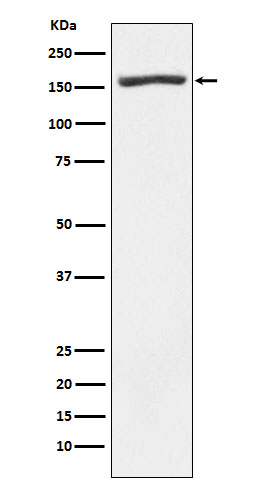
| WB | 1/1000-1/2000 | Human,Mouse,Rat |
| IF | 咨询技术 | Human,Mouse,Rat |
| IHC | 咨询技术 | Human,Mouse,Rat |
| ICC | 技术咨询 | Human,Mouse,Rat |
| FCM | 咨询技术 | Human,Mouse,Rat |
| Elisa | 咨询技术 | Human,Mouse,Rat |
| Aliases | Enactin; Ent; Entactin 1; Entactin; NID 1; NID; Nid1; Nidogen 1; Nidogen;;Nidogen 1 |
| WB Predicted band size | Calculated MW: 136 kDa ; Observed MW: 160 kDa |
| Host/Isotype | Rabbit IgG |
| Antibody Type | Primary antibody |
| Storage | Store at 4°C short term. Aliquot and store at -20°C long term. Avoid freeze/thaw cycles. |
| Species Reactivity | Human |
| Immunogen | A synthesized peptide derived from human Nidogen 1 |
| Formulation | Purified antibody in PBS with 0.05% sodium azide,0.05% BSA and 50% glycerol. |
+ +
以下是关于Nidogen1抗体的3篇参考文献,按作者和研究内容概括:
1. **文献名称**: *"Nidogen-1 regulates laminin-1-dependent mammary epithelial cell adhesion and migration"*
**作者**: Ekblom, P. et al.
**摘要**: 研究利用Nidogen1特异性抗体,发现其在基底膜中通过与层粘连蛋白(laminin)相互作用调控乳腺上皮细胞的黏附与迁移,揭示其在组织形态发生中的关键作用。
2. **文献名称**: *"Antibody-based targeting of Nidogen-1 blocks renal cell carcinoma invasion and metastasis"*
**作者**: Roca, H. et al.
**摘要**: 通过开发靶向Nidogen1的单克隆抗体,证明其能抑制肾癌细胞侵袭和转移,表明Nidogen1在肿瘤微环境中促进癌细胞扩散,抗体具有潜在治疗价值。
3. **文献名称**: *"Structural basis of Nidogen-1 recognition by the immune system"*
**作者**: Hopf, M. et al.
**摘要**: 利用X射线晶体学和Nidogen1抗体,解析了Nidogen1蛋白的抗原表位结构,为开发高特异性诊断抗体及研究其在自身免疫疾病中的作用提供依据。
4. **文献名称**: *"Nidogen-1 maintains vascular integrity and prevents aneurysms via interaction with perlecan"*
**作者**: Nielsen, J.S. & Miosge, N.
**摘要**: 研究通过免疫组化与Nidogen1抗体发现,其通过与基底膜蛋白perlecan结合维持血管壁完整性,缺失会导致动脉瘤形成,强调其在血管疾病中的保护作用。
这些文献涵盖Nidogen1抗体的功能研究、结构解析及疾病治疗应用,均发表于*Matrix Biology*、*Cancer Research*等期刊。如需具体年份或DOI可进一步补充。
Nidogen1. also known as entactin, is a key component of the basement membrane, a specialized extracellular matrix structure critical for tissue organization, cell adhesion, and signaling. It serves as a bridging molecule, facilitating interactions between laminin and collagen IV networks, thereby stabilizing basement membrane architecture. Nidogen1 is expressed in various tissues and plays roles in embryonic development, wound healing, and maintaining tissue integrity. Dysregulation of Nidogen1 has been implicated in diseases such as cancer metastasis, fibrosis, and kidney disorders.
Nidogen1 antibodies are essential tools for studying its expression, localization, and function in biological and pathological contexts. These antibodies are widely used in techniques like immunohistochemistry (IHC), immunofluorescence (IF), and Western blotting to visualize Nidogen1 distribution in tissues or assess its expression levels in experimental models. Researchers employ Nidogen1 antibodies to investigate basement membrane disruptions in genetic knockout studies, tumor microenvironment remodeling, or inflammatory conditions. Additionally, they help validate the success of gene-editing approaches (e.g., CRISPR) targeting Nidogen1. Commercially available antibodies are typically raised in rabbits or mice, with monoclonal and polyclonal variants offering different specificity and sensitivity profiles. Validation via knockout controls or siRNA knockdown is recommended to ensure reliability. Understanding Nidogen1 dynamics through antibody-based assays contributes to insights into tissue repair mechanisms and therapeutic targeting of basement membrane-related pathologies.
×